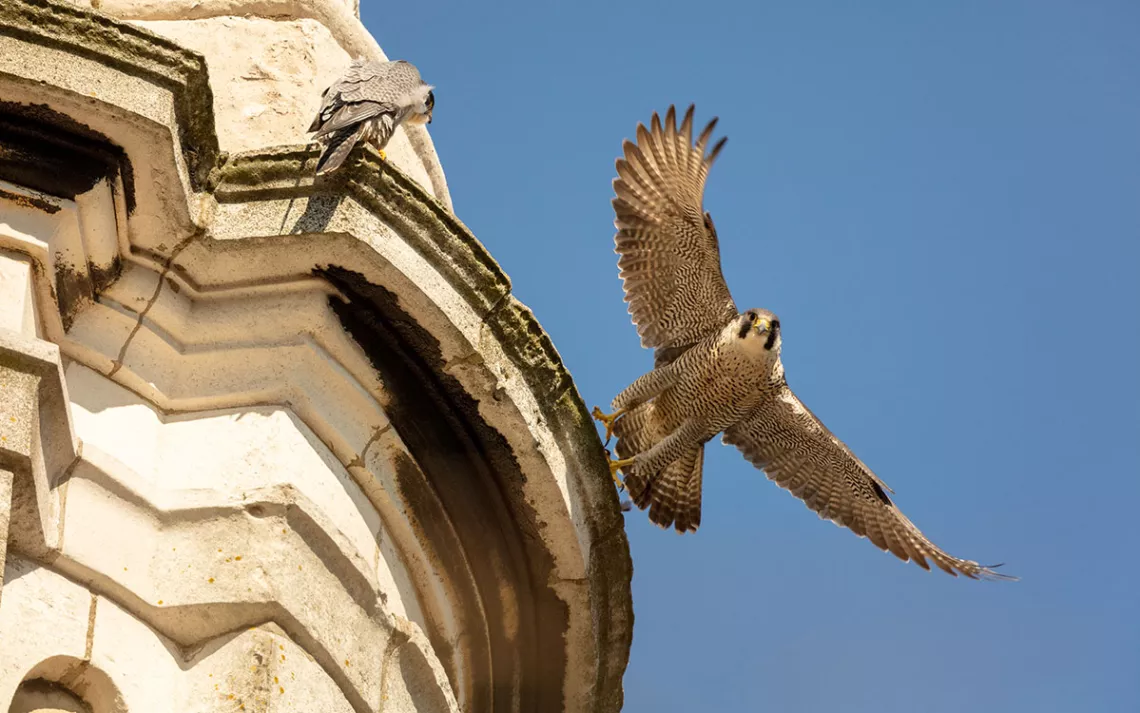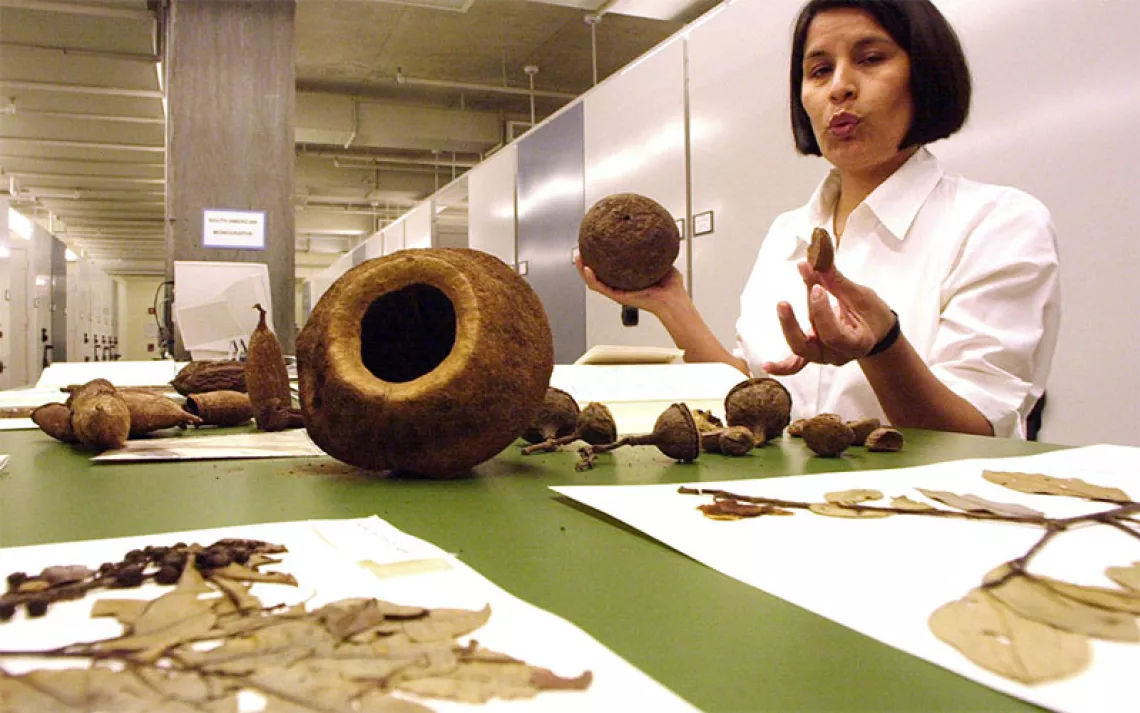The Pandemic Diet (For Falcons)
When Londoners stayed home, peregrine falcons ate less pigeon

Peregrine falcons on St. Paul’s Church, London. | Photo by Marshall Bruce/iStock
At the start of the pandemic, people around the world began spending long periods of time alone and indoors. Wildlife livestreams became extremely popular. “The viewership just went through the roof during lockdown,” says Brandon Mak, an urban ecologist in the Department of Geography at King's College London.
A peregrine falcon webcam at Ealing Hospital, in West London.
Mak happened to be investigating the diets of peregrine falcons, and the appeal of these wildlife webcams proved to be an unexpected asset. In 2020, Mak and a group of colleagues were able to recruit enough dedicated viewers from universities and local birdwatching groups to review livestreams from 16 building-top nest cameras across the country and record what the falcons were eating throughout their breeding season. This data collection method was so successful that the research team added even more nests to the study in 2021 and 2022.
All told, the nest cams covered 27 cities in the UK and 31 nests total. Some data sets were incomplete (one livestream was disrupted for several weeks due to a nest cam being pooped on) and several had to have their data discounted entirely for at least one season when the falcons didn’t successfully reproduce there. The volunteer falcon cam watchers were trained to identify all the prey that the falcons brought back to their nest. Over the three-year span of the study, they recorded over 8,000 individual animals caught by peregrine falcons throughout their March–June breeding season. “There's absolutely no way we would have got all that data if we had not had the commitment of those volunteers,” says Ed Drewitt, a freelance naturalist and wildlife ecologist at the University of Bristol who was a coauthor on the study.
After recording what peregrine falcons were eating for three consecutive breeding seasons, the research team found significant differences between the falcons’ 2020 diet, when the UK was in lockdown, compared to 2021 and 2022, which had no lockdowns during the spring breeding season. Their findings, recently published in the journal People and Nature, highlight the often unseen relationships between humans and wildlife in cities.
Unsurprisingly, the prey they caught was almost all birds (peregrine falcons are known bird specialists). Across all sites, the falcons ate a lot of pigeons and starlings. But when the researchers analyzed the data across years, they noticed shifts in the relative amounts of different bird species that falcons were catching.
A London falcon’s diet, for example, had a lower percentage of pigeons and a higher percentage of starlings and ring-necked parakeets during the 2020 breeding season, possibly due to there being fewer pigeons in urban areas during lockdown. In Singapore, a different group of researchers noticed a drop in feral pigeon numbers during lockdown. Many human activities provide food for pigeons, says Mak. Dropping trash is an obvious one, but even mowing lawns can make it easier for the birds to find seeds to eat. When Londoners stayed inside during the spring of 2020, pigeon numbers likely declined in the city, forcing peregrine falcons to change their diets.
The number of people who left London might have also contributed to the less pigeon-heavy diet of 2020. “There was a massive race for green space in London,” says Mak. “Everyone just wanted a piece of garden during lockdown.” London’s peregrine falcons seem to have compensated for the limited pigeon availability by eating more starlings and parakeets, which are less dependent on humans for food.
But Drewitt points out that these birds are smaller than pigeons, so the falcons would need to catch more of them to get the same amount of meat. “For every pigeon,” he says, a peregrine falcon would “probably want to eat two parakeets, and maybe three, maybe four starlings.”
The falcons in the 26 cities outside London also shifted their diet between years, but in different ways. The ring-necked parakeet—an introduced species in the UK—is not common outside of London. In the smaller cities, the falcons’ diet was primarily starlings and pigeons, with an occasional smattering of other birds.
During the lockdown of 2020, there was a drop in starling consumption outside London, though it rebounded in 2021 and 2022. The percentage of pigeons stayed roughly the same. The researchers suspect that in smaller cities, when human activity decreased at the city center, pigeons and starlings could probably find alternative feeding sites in the suburbs and natural areas on the outskirts of their city without having to travel too far. Because pigeons are physically bigger than starlings, they could have outcompeted smaller birds for these limited food sources, leading to a drop in starling numbers.
The researchers also looked into whether these shifts impacted the falcons’ reproduction. If the falcons’ preferred prey was less abundant during the lockdown, they might not be getting enough nutrition for themselves or their chicks. Despite the changes, they did not find differences between years in how many chicks hatched or survived to fledging age.
These results are encouraging from a conservation perspective, says Chris McClure, an ornithologist who was not involved in this study. “It shows that the birds are fairly resilient to changes in their diet and the availability of their prey species, so that gives us confidence that peregrines can bounce back from a lot.” McClure, who is the executive vice president of science and conservation at the Peregrine Fund, also notes that this kind of broad and flexible diet contributes to the peregrine falcon’s ability to live successfully all around the world.
A falcon cam maintained by researchers and volunteers at Charles Stuart University, in Australia.
Drewitt hopes that studying what falcons are eating can advance ongoing conservation efforts. In the UK, he says, some people kill falcons because they see them as threats to economically important birds like racing pigeons and grouse. “One of the reasons why they're illegally persecuted is because of what they eat,” he says. But some of the most frequent falcon prey recorded were those considered pests by many people, like the feral pigeons and the parakeets.
Peregrine falcons have not always been as abundant as they are today. In the mid-1900s, falcon populations in North America plummeted due to the widespread use of the pesticide DDT, which caused their eggshells to thin and break. Falcons in the UK were similarly threatened by a combination of toxic pesticides and illegal hunting. Banning DDT followed by decades of targeted conservation efforts brought their numbers up to where they are today.
“I find it a miracle that we have so many peregrines,” says Doug Bell, a wildlife program manager with the East Bay Regional Park District (also not involved in this study). “I have to pinch myself when I see a peregrine every now and then because I think back to the time when there literally were no peregrines and they were almost on the brink.”
A falcon cam at the University of California, Berkeley.
 The Magazine of The Sierra Club
The Magazine of The Sierra Club



